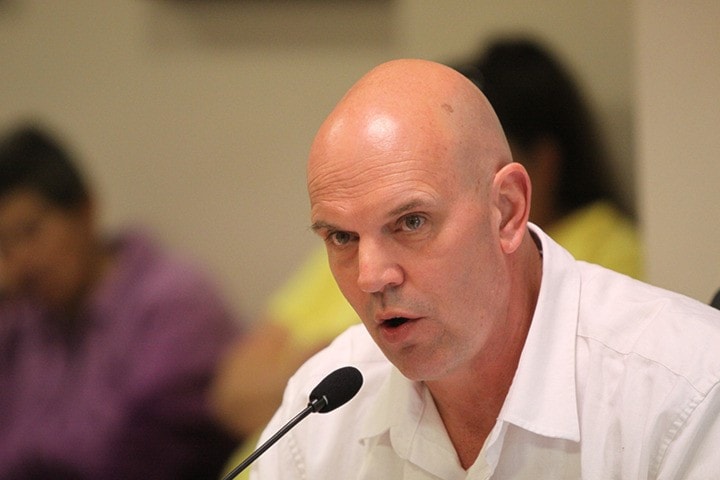Could municipalities and regional districts get into the medicinal marijuana growing business? There’s nothing to stop them, the MP for Kootenay-Columbia told the Regional District of Central Kootenay board Thursday.
David Wilks made a presentation on new rules to be phased in over the next year, which will see mom-and-pop medical grow operations replaced with larger operations with greater security.
Rural Castlegar director Andy Davidoff asked if any consideration has been given to local government getting involved. He suggested greenhouses could be built on landfill sites, powered by methane gas.
The federal government doesn’t prohibit any group from applying, Wilks replied. “The City of Kimberley asked me the other day with regards to the abandoned Sullivan mine. I went ‘Hm, interesting.’ Underground — you can’t get much better security than that.”
He said the bigger question is whether the average ratepayer would support their taxes being invested in such an operation.
“Would you be willing to look at a pilot in our area? And provide some seed money?” Davidoff asked, to laughter from some directors.
“I would suggest if there is one area in the country that could work as a pilot project, this would be it,” Wilks deadpanned.
After the meeting, Davidoff said he wasn’t being entirely facetious, and faced with downloading from senior governments and a “misperception” the regional district taxes heavily, they have to consider new revenue sources.
“Everything I said tongue-in-cheek is in the realm of possibility,” he said. “It would take the will of the board to look at the feasibility study. Hopefully we could lower taxes for our residents.”
Davidoff acknowledged there would be issues to get around, but “rest assured other municipalities will look at this very seriously.”
Extra security required
In his presentation, Wilks responded to a number of questions raised by regional district planning staff about how the new guidelines will affect them.
He explained anyone who applies to be a licensed producer will have to notify local government, police, and fire officials of their proposed location and plans. Health Canada would enforce the medical marijuana regulations while local government would continue to enforce its own bylaws.
Grow operations won’t be allowed outdoors or in homes, he said. “That was the largest problem with the old system. We have grow-ops within municipalities legislated by Health Canada and illegal grows as well and the police never knew which was which. This will make it very clear.”
Security requirements will also be beefed up substantially. “Security to have a new grow-op will be huge,” Wilks said. “It’s probably going to deter most people from wanting to do this.”
Under the old regulations, security was left up to the grower, he said. Under the new program, interior and exterior surveillance will be required at all times, both visual and electronic.
There will alarm systems, logbooks for anyone going in and out of restricted areas, and prospective employees will have to pass a criminal record check — as they do now — but it will be more stringent.
“It’s my understanding if there’s any criminal record, you will not be hired,” Wilks said. “Doesn’t matter what your crime was.”
Exhaust or air filter systems will also be required to prevent odors from escaping.
Getting the product
Wilks also explained that under the new guidelines, medical marijuana users who have a prescription will be able to go to a website and find a list of producers that indicates who they are, but not where they are.
Customers will be able to contact them to determine if they’re growing the marijuana that suits their medical needs and will be supplied directly by courier. Although there has been some talk of using pharmacies to dispense marijuana, Wilks said things haven’t progressed to that stage yet.
Health Canada will review the average per-gram price throughout North America and Europe and base its price accordingly.
The current program and new system will operate simultaneously until March 31, 2014, but as of October 1, 2013 the government will no longer accept applications under the old rules. Wilks said anyone who hasn’t already applied is probably too late, considering the 18-week growing cycles of the plants.
All personal production licenses will expire next April and holders will be required to destroy their crops or face prosecution. Wilks acknowledged many existing small producers may not be able to meet the new guidelines and may be displaced by larger operations.
He said 45,000 Canadians are currently authorized to use medicinal marijuana but that is expected to increase to between 100,000 and 200,000 in the next few years, requiring “a significant number of commercial growers with significant grow-ops.”
“Not everyone’s going to be happy but it will satisfy the concerns of law enforcement and of most regional and municipal politicians about grow-ops in residential areas,” he said.
Rural Kaslo director Andy Shadrack said Wilks addressed many issues municipalities have raised, but he remains concerned the legislation will be challenged by people who think they have the right to grow their own. “I’ll say what no one else around the table will today: we’ve got to legalize it,” Shadrack said. “That’s ultimately where we’ve got to go.
The regional district has already heard from one potential applicant who would like to establish a medical growing operation on the North Shore.
However, their variance application was denied and they were told to apply for rezoning instead. Under the new rules, commercial grow operations will have to be in agricultural or industrial areas.
